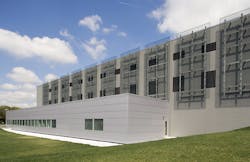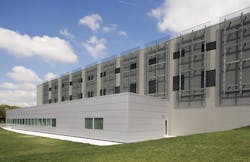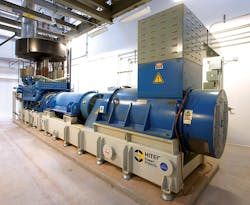Data Center Features Flexible Design and Power Options
Many of today’s data centers are built on the fast track. Some projects convert old abandoned industrial sites into new sophisticated technology centers. Others start with a clean site and build from the ground up, leaving lots of room for flexibility and customization in design. On the recent COPT DC-6 (formerly Powerloft @ Innovation) facility project, the project team implemented a smart expandable approach that was very closely aligned with their client’s business needs.
“We built the shell of both modules, but instead of fitting out 100,000 sq ft and having it sit there waiting for tenants, we built it in incremental stages,” says Steve Hughes, vice president for Clark Construction Group, the general contractor on the project. “That way, we could stay just ahead of the client’s leasing commitments, and the owner wasn’t overbuilt in terms of available space or utility capacity.”
Because the project was delivered at the height of the economic downturn, the company worked with the owner and engineer to come up with creative solutions to minimize expenses. By building the data center with a flexible design, the team was able to make forward progress on the project and minimize the turnaround time once the leases were executed.
Enhancing efficiency
Clark Mission Critical, a division of the Clark Construction Group, partnered with Dynalectric, a Dulles, Va.-based EMCOR company, and Reston, Va.-headquartered Truland Electric to build the COPT DC-6 project on a green field site in Manassas, Va.
The highly secure data center consists of two separate 100,000-sq-ft modules, each with 50,000 sq ft of raised floor over 50,000 sq ft of MEP space. In front of the data center, which was constructed as a steel structure with a masonry skin, stands a 16,000-sq-ft low-rise office building, which earned LEED gold certification.
The electrical design of the project is unique, highly flexible, and energy efficient. For example, tenants could deploy either AC or DC power to IT equipment at densities up to 300W per sq ft. The initial design concept was also based upon 15kV medium-voltage power distribution with large-scale rotary UPS units.
The construction team built the rotary UPS concept during the first module. While the workers were completing the construction of the first module, they also started to build out the structure and exterior envelope for the second data center module. Rather than finishing out the second module, however, they left the module in shell condition and did not install the underslab utilities and slab-on-grade. That way, they could defer costs and provide flexibility to incorporate any future design changes.
The flexibility in design allowed the team to install different types of UPS units in each module. As the first module was under construction, the flexible design allowed the project owners to implement static UPS design in the second module with minimal effect on the already completed work.
“The primary focus during construction of the second module was to maintain uninterrupted operation of the first data center module,” says Hughes. “It also required extensive coordination meetings and highly detailed methods of procedure for any operation that could affect electric utility service to the first module.”
Truland Electric, which was selected as the electrical subcontractor for the second module, worked with Clark and the design team to develop a plan to use the existing site infrastructure and modify power distribution to support the installation of medium-voltage unit substations. This work required detailed coordination to meet the new owner’s phasing plan and delivery schedule.
Installing electrical equipment
Clark engaged the electrical and mechanical contractors early in the process so they could provide design input and coordinate the owner-furnished equipment. For example, on the first data center module, Dynalectric worked closely with the client, the electrical design engineer, and the owner’s equipment vendor to provide input on design decisions, review development of the design documents, and coordinate the owner’s procurement of the rotary UPS equipment and switchgear for the first phase of the project.
In response to the client’s request to incrementally phase the project, Dynalectric and Clark created a detailed phasing plan to minimize the client’s capital investment while advancing construction ahead of client occupancy dates. As part of this phasing process, the team also developed a creative approach to use temporary equipment as well as install permanent equipment in temporary locations. For example, workers installed temporary air-cooled chillers to meet initial cooling loads prior to construction of the site’s permanent chiller plant.
Additionally, workers installed the generators supporting the temporary chillers in the rotary UPS building in bays where future rotary UPS units would be located. The companies also procured and installed the switchgear designated to support IT loads in its permanent location and then used the switchgear to provide power to the temporary chillers. This solution allowed existing duct banks running from the rotary UPS building to the data center to be used to route electrical cabling to the temporary generators without purchasing unnecessary additional switchgear. The phasing plan also included detailed steps on how to migrate equipment to its permanent location and install additional equipment. At the same time, the firms were able to maintain uninterrupted service to existing data center tenants.
Implementation of this phasing approach required additional design by the electrical and mechanical engineers as well as detailed coordination with the owner-furnished equipment vendor. The plan also required revised permitting and cooperation with the building inspectors. Despite the additional effort, this entire process deferred more than $10 million of construction cost and became instrumental to the client’s business model.
Coordinating the field workforce
At the peak of construction, about 500 workers were on the job site, but because the building was not built all at one time, the workforce was staggered. The electrical and mechanical contractors scaled their workforce up or down depending upon the amount of work on the job site. Dynalectric maintained the same management staff throughout all phases of the buildout of the first module, and many of the same workers remained on site for subsequent phases of work. This continuity of staffing and project knowledge was instrumental in effectively coordinating the work between phases.
“We had to make sure that from a pre-construction, budgeting, planning, and scheduling standpoint, everyone was in step with how the project needed to be laid out and built,” says Hughes. “It was a unique data center concept due to the design configuration and its relationship with the supporting electrical and mechanical infrastructure.”
Because the project ran over several years, it demanded not only significant coordination, but also cooperation from the entire team for the long haul, adds Hughes. Rather than a rushed data center build — as is the case with many of today’s construction projects — the team had to work together for the long-term, be flexible, and install a wide variety of equipment to meet tenants’ current and future needs.
“The creativity, flexibility, cooperation, and commitment to client satisfaction by the electrical subcontractors were critical to the success of the project,” says Hughes.
Fischbach is a freelance writer based in Overland Park, Kan. She can be reached at [email protected].


